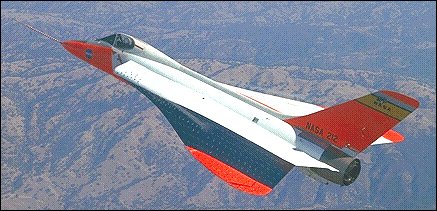|
| The Douglas F5D was envisaged originally as an improved all-weather development of the F4D (F-6) Skyray, and two prototypes were ordered in 1953 under the designation F4D-2N. However, substantial changes, including wings of much reduced thickness/chord ratio, a lengthened fuselage, revised vertical tail surfaces and the introduction of a new cockpit canopy brought the rede-signation F5D-1 (subsequently named Skylancer) before the first flight was recorded on 21 April 1956.
By then, nine preproduction and 51 production examples had been ordered, but following early flight testing the programme was cancelled exceptfor two of the preproduction aircraft. This termination was not due to shortcomings in the aircraft, but rather.to the realisation that the performance of the F5D was little better than that of the Chance Vought F8U-1 which was on the point of entering service. However, the four F5D-1s fulfilled a useful role, being used by the US Navy as flying testbeds for a variety of equipment before they were handed over to NASA for experimental use.
 | A three-view drawing (1683 x 1373) |
| MODEL | F5D |
| CREW | 1 |
| ENGINE | 1 x Pratt-Whitney J57-P-8, 7250kg |
| WEIGHTS |
| Take-off weight | 12733 kg | 28072 lb |
| Empty weight | 7912 kg | 17443 lb |
| DIMENSIONS |
| Wingspan | 10.21 m | 34 ft 6 in |
| Length | 16.4 m | 54 ft 10 in |
| Height | 4.52 m | 15 ft 10 in |
| Wing area | 51.75 m2 | 557.03 sq ft |
| PERFORMANCE |
| Max. speed | 1760 km/h | 1094 mph |
| Cruise speed | 1025 km/h | 637 mph |
| Ceiling | 17500 m | 57400 ft |
| Range | 2140 km | 1330 miles |
| Bob Harrison, e-mail, 24.07.2012 08:18 The F-8 was anything but "an ordinary aircraft by comparison." The Crusader, according to several Navy pilots who flew both extensively, was a better all around aircraft. It was faster, had much better range, had better energy maneuverability (if not a tighter turn radius)and was a better air-to-ground platform. reply | | Richard J. Arabian, e-mail, 25.04.2012 02:42 As a supplement to my comments of 12-16-09, the photo featured here is in fact the first of four airframes completed, tail number 208, after being turned over to NACA and modified with the "Ogee" wing platform in support of SST development work. The changes, done with plywood and fiberglas, naturally limited IAS and distracted from the even more attractive lines of the original configuration, moving the intact lips forward and re-contouring the leading edges. As previously mentioned, this aircraft is currently displayed at the Ontario, OR airport. reply | | that guy, 30.03.2012 00:58 Unfortunately with missile technology. The way it was it wasn't that great. Beautiful. Though reply | | zhuma, 21.06.2011 06:05 and it is a pity that the decision to go with the F8 Crusader (an ordinary aircraft in comparison) was politically based. An oportunity missed. reply | |
| | bombardier, e-mail, 24.05.2011 13:58 Top speed was 1.540 km /h not 1.760 reply | | John Dighton, e-mail, 15.10.2010 15:28 A beautiful aircraft indeed, which is unusual for an American aircraft. The wing planform of 60 degree sweep is the basis of all modern interceptors and thus was advanced for the time. It had high development potential and it is a pity that the decision to go with the F8 Crusader (an ordinary aircraft in comparison) was politically based. An oportunity missed. reply | | Geoff Gunning, e-mail, 19.01.2010 04:11 Arguably the most beautiful jet-powered design of all time. I expect it would have gained all sorts of protruberances had it gone into service (look what happened to the Skyhawk), but it certainly started as perfection. reply | | Richard J. Arabian, e-mail, 16.12.2009 01:14 Fortunately (2)intact airframes remain; one at the Neil Armstrong Museum in Ohio and another displayed at the Ontario,OR airport along with numerous other military types of that period. The former is the last F5D-1 built (350)while the latter is the first (208). reply |
|
Do you have any comments?
|
| 
COMPANY
PROFILE
All the World's Rotorcraft
|







